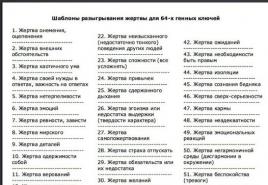Determination of the equation of a line on a plane. Analytic geometry
As you know, any point on a plane is determined by two coordinates in any coordinate system. Coordinate systems can be different depending on the choice of the base and origin.
Definition: The equation of a line is the ratio y \u003d f (x) between the coordinates of the points that make up this line.
Note that the equation of the line can be expressed parametrically, that is, each coordinate of each point is expressed in terms of some independent parameter t... A typical example is the trajectory of a moving point. In this case, time plays the role of a parameter.
Different kinds of straight line equation
General equation of the line.
Any straight line on a plane can be given by a first-order equation
Ax + Wu + C \u003d 0,
moreover, the constants A, B are not equal to zero at the same time, i.e. А 2 + В 2 ¹ 0. This first-order equation is called the general equation of the line .
Depending on the values constants A, B and C the following special cases are possible:
C \u003d 0, A ¹ 0, B ¹ 0 - the line passes through the origin
A \u003d 0, B ¹ 0, C ¹ 0 (By + C \u003d 0) - the straight line is parallel to the Ox axis
B \u003d 0, A ¹ 0, C ¹ 0 (Ax + C \u003d 0) - the straight line is parallel to the Oy axis
B \u003d C \u003d 0, A ¹ 0 - the straight line coincides with the Oy axis
A \u003d C \u003d 0, B ¹ 0 - the straight line coincides with the Ox axis
The equation of a straight line can be presented in different forms depending on any given initial conditions.
Equation of a straight line passing through two points.
Let two points M 1 (x 1, y 1, z 1) and M 2 (x 2, y 2, z 2) be given in space, then the equation of the straight line passing through these points:
If any of the denominators is zero, the corresponding numerator should be equated to zero. On the plane, the equation of the straight line written above is simplified:
if x 1 ¹ x 2 and x \u003d x 1, if x 1 \u003d x 2.
The fraction \u003d k is called the slope of the straight line.
Equation of a straight line by point and slope.
If the general equation of the straight line Ax + Vy + C \u003d 0 is reduced to the form:
and denote, then the resulting equation is called the equation of a straight line with a slope k.
Equation of a straight line in segments.
If in the general equation of the straight line Ax + Vy + C \u003d 0 C ¹ 0, then, dividing by –C, we get: or
The geometric meaning of the coefficients is that the coefficient and is the coordinate of the point of intersection of the straight line with the Ox axis, and b - the coordinate of the point of intersection of the straight line with the Oy axis.
Normal equation of a straight line.
If both sides of the equation Ax + Vy + C \u003d 0 are divided by the number, which is called the normalizing factor, then we get
xcosj + ysinj - p \u003d 0 -
normal equation of a straight line.
The ± sign of the normalizing factor should be chosen so that m × С< 0.
p is the length of the perpendicular dropped from the origin to the straight line, and j is the angle formed by this perpendicular with the positive direction of the Ox axis.
The angle between straight lines on the plane.
If two straight lines are given y \u003d k 1 x + b 1, y \u003d k 2 x + b 2, then sharp corner between these lines will be defined as
Two straight lines are parallel if k 1 \u003d k 2.
Two straight lines are perpendicular if k 1 \u003d -1 / k 2.
Theorem. The straight lines Ax + Vy + C \u003d 0 and A 1 x + B 1 y + C 1 \u003d 0 are parallel when the coefficients A 1 \u003d lA, B 1 \u003d lB are proportional. If also С 1 \u003d lС, then the lines coincide.
The coordinates of the point of intersection of two straight lines are found as a solution to a system of two equations.
Distance from point to line.
Theorem. If a point M (x 0, y 0) is given, then the distance to the straight line Ax + Vy + C \u003d 0 is determined as
Lecture 5
Introduction to Analysis. Differential calculus of a function of one variable.
LIMIT OF FUNCTION
Limit of a function at a point.
0 a - D a a + D x
Figure 1. Limit of a function at a point.
Let the function f (x) be defined in some neighborhood of the point x \u003d a (i.e., at the point x \u003d a itself, the function may not be defined)
Definition. A number A is called the limit of a function f (x) as x®a if for any e\u003e 0 there exists a number D\u003e 0 such that for all x such that
0 < ïx - aï < D
the inequality ïf (x) - Aï< e.
The same definition can be written in a different form:
If a - D< x < a + D, x ¹ a, то верно неравенство А - e < f(x) < A + e.
Recording the limit of a function at a point:
Definition.
If f (x) ® A 1 for x ® and only for x< a, то - называется пределом функции f(x) в точке х = а слева, а если f(x) ® A 2 при х ® а только при x > a, then it is called the limit of the function f (x) at the point x \u003d a on the right.
The above definition refers to the case when the function f (x) is not defined at the point x \u003d a itself, but is defined in some arbitrarily small neighborhood of this point.
The limits A 1 and A 2 are also called unilateral limits of the function f (x) at the point x \u003d a. It is also said that A - finite function limit f (x).
Equation of a line in a plane
The main questions of the lecture: equations of a line on a plane; various forms of the equation of a straight line on a plane; angle between straight lines; conditions of parallelism and perpendicularity of straight lines; distance from point to straight line; curves of the second order: circle, ellipse, hyperbola, parabola, their equations and geometric properties; equations of a plane and a straight line in space.
An equation of the form is called a straight line equation in general form.
If expressed in this equation, then after replacing and we get an equation called the equation of a straight line with an angular coefficient, where, where is the angle between the straight line and the positive direction of the abscissa axis. If, in the general equation of the straight line, we transfer the free coefficient to the right side and divide it by it, then we obtain the equation in segments
Where and are the points of intersection of the straight line with the abscissa and ordinate axes, respectively.
Two straight lines on a plane are called parallel if they do not intersect.
Lines are called perpendicular if they intersect at right angles.
Let two lines and are given.
To find the point of intersection of lines (if they intersect), you need to solve a system with these equations. The solution of this system will be the point of intersection of the lines. Let's find the conditions mutual arrangement two straight lines.
As ![]() , then the angle between these lines is found by the formula
, then the angle between these lines is found by the formula
From this it can be obtained that, for, the lines will be parallel, and for, they will be perpendicular. If the lines are given in general form, then the lines are parallel under the condition and perpendicular under the condition
The distance from a point to a straight line can be found by the formula

Normal equation of a circle:
![]()
An ellipse is a locus of points on a plane, the sum of the distances from which to two given points, called foci, is a constant value.
The canonical equation of the ellipse is:
![]() ... The vertices of the ellipse are the points,,,. The eccentricity of an ellipse is the ratio
... The vertices of the ellipse are the points,,,. The eccentricity of an ellipse is the ratio
A hyperbola is a locus of points on a plane, the modulus of the difference between distances from which to two given points, called foci, is a constant value.
The canonical hyperbola equation is:
where is the semi-major axis, is the semi-minor axis and. Focuses are in points ![]() ... The vertices of the hyperbola are the points,. The eccentricity of the hyperbola is the ratio
... The vertices of the hyperbola are the points,. The eccentricity of the hyperbola is the ratio
The straight lines are called asymptotes of the hyperbola. If, then the hyperbola is called isosceles.
From the equation we obtain a pair of intersecting lines and.
A parabola is a locus of points on a plane, from each of which the distance to a given point, called the focus, is equal to the distance to a given straight line, called the directrix, there is a constant value.
Canonical parabola equation
The straight line is called the directrix, and the point is called the focus.
Functional dependency concept
The main questions of the lecture: sets; basic set operations; definition of a function, its area of \u200b\u200bexistence, methods of assignment; the main elementary functions, their properties and graphs; numerical sequences and their limits; the limit of the function at a point and at infinity; infinitely small and infinitely large quantities and their properties; basic theorems on limits; wonderful limits; continuity of a function at a point and on an interval; properties of continuous functions.
If a well-defined element of the set is assigned to each element of a set, then they say that a function is given on the set. In this case, it is called the independent variable or argument, and the dependent variable, and the letter denotes the law of correspondence.
The set is called the domain of definition or existence of the function, and the set is called the domain of the function.
There are the following ways to set the function
1. Analytical method, if the function is given by a formula of the form
2. Tabular way is that the function is specified by a table containing the values \u200b\u200bof the argument and the corresponding values \u200b\u200bof the function
3. The graphical method consists in displaying the graph of a function - a set of points on the plane, the abscissas of which are the values \u200b\u200bof the argument, and the ordinates are the corresponding values \u200b\u200bof the function
A line on a plane is a set of points of this plane that have certain properties, while points that do not lie on a given line do not have these properties. The line equation defines an analytically expressed relationship between the coordinates of points lying on this line. Let this relation be given by the equation
F ( x, y)=0. (2.1)
A pair of numbers satisfying (2.1) is not arbitrary: if x given, then at cannot be anything, value at associated with x... When it changes x changes at, and a point with coordinates ( x, y) describes this line. If the coordinates of the point М 0 ( x 0 ,at 0) satisfy equation (2.1), i.e. F ( x 0 ,at 0) \u003d 0 - true equality, then point М 0 lies on this line. The converse is also true.
Definition. The equation of a line on a plane is an equation that is satisfied by the coordinates of any point lying on this line, and the coordinates of points that do not lie on this line are not satisfied.
If the equation of a certain line is known, then the study of the geometric properties of this line can be reduced to the study of its equation - this is one of the basic ideas of analytical geometry. For the study of equations, there are well-developed methods of mathematical analysis that simplify the study of the properties of lines.
When considering lines, the term is used current point lines - variable point M ( x, y) moving along this line. Coordinates x and at current point are called current coordinates line points.
If from equation (2.1) it is possible to express explicitly at
through x, i.e., write equation (2.1) in the form, then the curve defined by such an equation is called schedule function f (x).
1. The equation is given:, or. If a x takes arbitrary values, then at takes values \u200b\u200bequal to x... Consequently, the line defined by this equation consists of points equidistant from the coordinate axes Ox and Oy - this is the bisector of the I – III coordinate angles (straight line in Fig. 2.1).
The equation, or, determines the bisector of the II – IV coordinate angles (straight line in Fig. 2.1).


 at at
at at
0 x 0 x C 0 x
fig. 2.1 fig. 2.2 fig. 2.3
2. The equation is given:, where C is some constant. This equation can be written differently: ![]() ... This equation is satisfied by those and only those points, ordinates at which are equal to C for any value of the abscissa x... These points lie on a straight line parallel to the Ox axis (Fig. 2.2). Similarly, the equation defines a straight line parallel to the Oy axis (Figure 2.3).
... This equation is satisfied by those and only those points, ordinates at which are equal to C for any value of the abscissa x... These points lie on a straight line parallel to the Ox axis (Fig. 2.2). Similarly, the equation defines a straight line parallel to the Oy axis (Figure 2.3).
Not every equation of the form F ( x, y) \u003d 0 defines a line on the plane: the equation is satisfied by a single point - О (0,0), and the equation ![]() does not satisfy any point on the plane.
does not satisfy any point on the plane.
In the given examples, we constructed a line determined by this equation using a given equation. Consider the inverse problem: draw up its equation along a given line.
3. Make the equation of a circle centered at point P ( a, b) and
radius R .
○ A circle with center at point P and radius R is a set of points spaced from point P at a distance R. This means that for any point M lying on the circle, MP \u003d R, if point M does not lie on the circle, then MP ≠ R.
As you know, any point on a plane is determined by two coordinates in any coordinate system. Coordinate systems can be different depending on the choice of the base and origin.
Definition. Equation lineis called the ratio y \u003d f (x) between the coordinates of the points that make up this line.
Note that the equation of the line can be expressed parametrically, that is, each coordinate of each point is expressed in terms of some independent parameter t.
A typical example is the trajectory of a moving point. In this case, time plays the role of a parameter.
Equation of a straight line on a plane.
Definition. Any straight line on a plane can be given by a first-order equation
Ax + Wu + C \u003d 0,
moreover, the constants A, B are not equal to zero at the same time, i.e. А 2 + В 2 ¹ 0. This first-order equation is called the general equation of the straight line.
Depending on the values \u200b\u200bof constants A, B and C, the following special cases are possible:
C \u003d 0, A ¹ 0, B ¹ 0 - the line passes through the origin
A \u003d 0, B ¹ 0, C ¹ 0 (By + C \u003d 0) - the straight line is parallel to the Ox axis
B \u003d 0, A ¹ 0, C ¹ 0 (Ax + C \u003d 0) - the straight line is parallel to the Oy axis
B \u003d C \u003d 0, A ¹ 0 - the straight line coincides with the Oy axis
A \u003d C \u003d 0, B ¹ 0 - the straight line coincides with the Ox axis
The equation of a straight line can be presented in different forms depending on any given initial conditions.
Equation of a straight line along a point and a normal vector.
Definition. In a Cartesian rectangular coordinate system, a vector with components (A, B) is perpendicular to the straight line given by the equation Ax + Vy + C \u003d 0.
Example. Find the equation of the straight line passing through the point A (1, 2) perpendicular to the vector (3, -1).
At A \u003d 3 and B \u003d -1, we compose the equation of the straight line: 3x - y + C \u003d 0. To find the coefficient C, we substitute the coordinates of a given point A into the resulting expression.
We get: 3 - 2 + C \u003d 0, therefore C \u003d -1.
Total: the required equation: 3x - y - 1 \u003d 0.
Equation of a straight line passing through two points.
Let two points M 1 (x 1, y 1, z 1) and M 2 (x 2, y 2, z 2) be given in space, then the equation of the straight line passing through these points:
![]()
If any of the denominators is zero, the corresponding numerator should be equated to zero.
On the plane, the equation of the straight line written above is simplified: ![]()
if x 1 ¹ x 2 and x \u003d x 1, if x 1 \u003d x 2.
Fraction \u003d k is called slope straight.
Example. Find the equation of the straight line passing through the points A (1, 2) and B (3, 4).
Applying the above formula, we get:

Equation of a straight line by point and slope.
If the general equation of the straight line Ax + Vy + C \u003d 0 is reduced to the form:
and denote, then the resulting equation is called equation of a straight line with slope k.
Equation of a straight line along a point and a direction vector.
By analogy with the paragraph considering the equation of a straight line through the normal vector, you can enter the specification of a straight line through a point and a direction vector of a straight line.
Definition. Each nonzero vector (a 1, a 2) whose components satisfy the condition Aa 1 + Ba 2 \u003d 0 is called the directing vector of the line
Ax + Wu + C \u003d 0.
Example. Find the equation of a straight line with a direction vector (1, -1) and passing through point A (1, 2).
The equation of the desired straight line will be sought in the form: Ax + By + C \u003d 0. According to the definition, the coefficients must satisfy the conditions.
This article is a continuation of the section on a straight line on a plane. Here we turn to the algebraic description of a straight line using the equation of a straight line.
The material of this article is the answer to the questions: "What equation is called the equation of a straight line and what form does the equation of a straight line on a plane have"?
Page navigation.
Equation of a straight line on a plane - definition.
Let Oxy be fixed on the plane and a straight line is given in it.
Straight like any other geometric figure, consists of points. In a fixed rectangular coordinate system, each point of a straight line has its own coordinates - an abscissa and an ordinate. So the relationship between the abscissa and the ordinate of each point of a straight line in a fixed coordinate system can be set by an equation called the equation of a straight line on a plane.
In other words, equation of a straight line on a plane in the rectangular coordinate system Oxy there is some equation with two variables x and y, which becomes an identity when the coordinates of any point of this straight line are substituted into it.
It remains to deal with the question of what form the equation of a straight line on a plane has. The answer to it is contained in the next paragraph of the article. Looking ahead, we note that there are various forms of writing the equation of a straight line, which is explained by the specifics of the problems being solved and the method of specifying a straight line on a plane. So, let's start an overview of the main types of the equation of a straight line on a plane.
General equation of the line.
The form of the equation of a straight line in a rectangular coordinate system Oxy on a plane is given by the following theorem.
Theorem.
Any equation of the first degree with two variables x and y of the form, where A, B and C are some real numbers, and A and B are not simultaneously zero, defines a straight line in the rectangular coordinate system Oxy on the plane, and any straight line on the plane is given by the equation kind ![]() .
.
The equation ![]() called the general equation of the straight line on surface.
called the general equation of the straight line on surface.
Let us explain the meaning of the theorem.
To a given equation of the form ![]() corresponds to a straight line on a plane in a given coordinate system, and a straight line on a plane in a given coordinate system corresponds to a straight line equation of the form
corresponds to a straight line on a plane in a given coordinate system, and a straight line on a plane in a given coordinate system corresponds to a straight line equation of the form ![]() .
.
Look at the drawing.

On the one hand, we can say that this line is determined by the general equation of a straight line of the form ![]() , since the coordinates of any point of the depicted line satisfy this equation. On the other hand, the set of points in the plane defined by the equation
, since the coordinates of any point of the depicted line satisfy this equation. On the other hand, the set of points in the plane defined by the equation ![]() give us the straight line shown in the drawing.
give us the straight line shown in the drawing.
The general equation of the line is called completeif all the numbers A, B and C are nonzero, otherwise the general equation of the line is called incomplete... An incomplete equation of a straight line of the form defines a straight line passing through the origin. For A \u003d 0 the equation ![]() specifies a straight line parallel to the abscissa axis Ox, and at B \u003d 0 - parallel to the ordinate axis Oy.
specifies a straight line parallel to the abscissa axis Ox, and at B \u003d 0 - parallel to the ordinate axis Oy.
Thus, any straight line on a plane in a given rectangular coordinate system Oxy can be described using general equation a straight line for some set of values \u200b\u200bof the numbers A, B and C.
Normal vector of a straight line defined by the general equation of a straight line of the form ![]() , has coordinates.
, has coordinates.
All the equations of the straight lines, which are given in the following paragraphs of this article, can be obtained from the general equation of the straight line, and can also be reduced back to the general equation of the straight line.
We recommend the article for further study. There, the theorem formulated at the beginning of this paragraph of the article is proved, graphic illustrations are given, solutions of examples for drawing up the general equation of a straight line are discussed in detail, the transition from the general equation of a straight line to equations of a different kind and vice versa is shown, and other typical problems are considered.
Equation of a straight line in segments.
An equation of a straight line, where a and b are some real numbers other than zero, is called the equation of the line in the segments... This name is not accidental, since the absolute values \u200b\u200bof the numbers a and b are equal to the lengths of the segments that the line cuts off on the coordinate axes Ox and Oy, respectively (the segments are measured from the origin). Thus, the equation of a line in segments makes it easy to build this line in the drawing. To do this, mark in a rectangular coordinate system on the plane points with coordinates and, and use a ruler to connect them with a straight line.
As an example, let's build a straight line given by an equation in segments of the form. Marking points  and connect them.
and connect them.

You can get detailed information about this kind of equation of a straight line on a plane in the article.
Equation of a straight line with a slope.
An equation of a straight line, where x and y are variables, and k and b are some real numbers, is called equation of a straight line with slope (k is the slope). The equations of a straight line with a slope are well known to us from the course of algebra high school... This form of the equation of the straight line is very convenient for research, since the variable y is an explicit function of the argument x.
The definition of the slope of a straight line is given by determining the angle of inclination of a straight line to the positive direction of the Ox axis.
Definition.
The angle of inclination of the straight line to the positive direction of the abscissa axis in a given rectangular Cartesian coordinate system Oxy is the angle measured from the positive direction of the Ox axis to a given straight line counterclockwise.
If a straight line is parallel to the abscissa axis or coincides with it, then its angle of inclination is considered equal to zero.
Definition.
Slope of a straight line is the tangent of the slope of this straight line, that is,.
If the line is parallel to the ordinate axis, then the slope becomes infinity (in this case, they also say that the slope does not exist). In other words, we cannot write the equation of a straight line with a slope for a straight line parallel or coinciding with the Oy axis.
Note that the straight line defined by the equation passes through a point on the ordinate axis.
Thus, the equation of a straight line with a slope determines a straight line on the plane passing through a point and forming an angle with the positive direction of the abscissa axis, and.
As an example, we will depict a straight line determined by an equation of the form. This line goes through a point and has a slope ![]() radians (60 degrees) to the positive direction of the Ox axis. Its slope is.
radians (60 degrees) to the positive direction of the Ox axis. Its slope is.

Note that it is very convenient to search precisely in the form of an equation of a straight line with a slope.
Canonical equation of a straight line on a plane.
Canonical equation of a straight line on a plane in a rectangular Cartesian coordinate system Oxy has the form  , where and are some real numbers, and at the same time are not equal to zero.
, where and are some real numbers, and at the same time are not equal to zero.
Obviously, a straight line, defined by the canonical equation of a straight line, passes through a point. In turn, the numbers and in the denominators of the fractions represent the coordinates of the direction vector of this straight line. Thus, the canonical equation of a straight line in a rectangular coordinate system Oxy on a plane corresponds to a straight line passing through a point and having a direction vector.
For example, let us draw on the plane a straight line corresponding to the canonical equation of a straight line of the form  ... Obviously, the point belongs to the line, and the vector is the direction vector of this line.
... Obviously, the point belongs to the line, and the vector is the direction vector of this line.

The canonical straight-line equation is used even when one of the numbers or is equal to zero. In this case, the record is considered conditional (since there is zero in the denominator) and it should be understood as ![]() ... If, then the canonical equation takes the form
... If, then the canonical equation takes the form  and defines a straight line parallel to the ordinate axis (or coinciding with it). If, then the canonical equation of the line takes the form
and defines a straight line parallel to the ordinate axis (or coinciding with it). If, then the canonical equation of the line takes the form  and defines a straight line parallel to the abscissa axis (or coinciding with it).
and defines a straight line parallel to the abscissa axis (or coinciding with it).
Detailed information about the equation of a straight line in the canonical form, as well as detailed solutions of typical examples and problems are collected in the article.
Parametric equations of a straight line on a plane.
Parametric equations of a straight line on a plane have the form  , where and are some real numbers, and at the same time are not equal to zero, but is a parameter that takes any real values.
, where and are some real numbers, and at the same time are not equal to zero, but is a parameter that takes any real values.
Parametric equations of a straight line establish an implicit relationship between the abscissas and ordinates of points of a straight line using a parameter (hence the name of this type of equations of a straight line).
A pair of numbers, which are calculated by the parametric equations of a straight line at some real value of the parameter, represent the coordinates of some point on the straight line. For example, for we have  , that is, the point with coordinates lies on a straight line.
, that is, the point with coordinates lies on a straight line.
It should be noted that the coefficients and at the parameter in the parametric equations of the straight line are the coordinates of the direction vector of this straight line.







